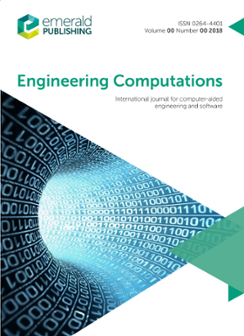Engineering Computations: Volume 6 Issue 2
Strapline:
International journal for computer-aided engineering and softwareTable of contents
Free vibrations of Mindlin plates using the finite element method: Part 1. Square plates with various edge conditions
Bahaa S. Al Janabi, E. Hinton, Dj. VuksanovicThis paper presents a parametric study of the free vibrations of square plates with various thickness‐to‐span ratios and different boundary conditions. The numerical analysis of…
Intelligent real‐time system management: towards an operator companion for nuclear power plants
W.J. Garland, W.F.S. Poehlman, N. Solntseff, J. Hoskins, L. WilliamsThis paper reports on an investigation of the integration of symbolic computation and reasoning into highly computerized numerically‐based realtime control systems for complex…
An assessment of numerical algorithms for plane stress and shell elastoplasticity on supercomputers
Robert G. Whirley, John O. Hallquist, Gerald L. GoudreauRecent progress in element technology in large scale explicit finite element codes has opened the way for the solution of elastoplastic shell problems of unprecedented complexity…
Finite element modelling of the near wall zone of confined turbulent flows
J.Y. Xia, C. Taylor, J.O. MedwellAn inherent problem when analysing confined turbulent flows, using a numerical approach, is mapping within the conventionally termed ‘near wall zone’. In order to accommodate the…
Finite element analysis of temperatures and stresses in a single‐pass butt‐welded pipe—influence of mesh density and material modelling
C.T. KarlssonSingle‐pass girth butt welding of a carbon‐manganese pipe is studied numerically using the finite element codes ADINAT/ADINA. A rotationally symmetric finite element model is…
The discrete vortex method and parallel processing using transputers
Martin J. Downie, Peter BettessA simple discrete vortex program written in the Occam language for implementation on transputers is presented. The programming methodology and logic are described, with an…
Using Lanczos vectors and Ritz vectors for computing dynamic responses
Harn C. Chen, Robert L. TaylorThe Lanczos vectors and the Ritz vectors have been used for computing the dynamic response of linear structures. Although the procedures of using these two sets of vectors appear…
A virtual work derivation of the Biot consolidation finite element formulation
D. Ding, D.J. NaylorA derivation for the finite element equations of consolidation by the principle of virtual work and virtual complementary work is presented. This provides a simple alternative to…
Linearization of elasto‐plastic consolidation equations
Ronaldo I. BorjaIn the framework of the finite element method, the problem of elasto‐plastic consolidation gives rise to a system of non‐linear, coupled residual equations which satisfy the…
An iterative solution to non‐symmetric diagonal dominant simultaneous equations
A.H.C. ChanThe Lanczos method with the Golub and Kahan bidiagonalization algorithm is used to solve non‐symmetric diagonal dominant simultaneous equations. The method is very suitable for…

ISSN:
0264-4401Online date, start – end:
1984Copyright Holder:
Emerald Publishing LimitedOpen Access:
hybridEditor:
- Prof. Chenfeng Li